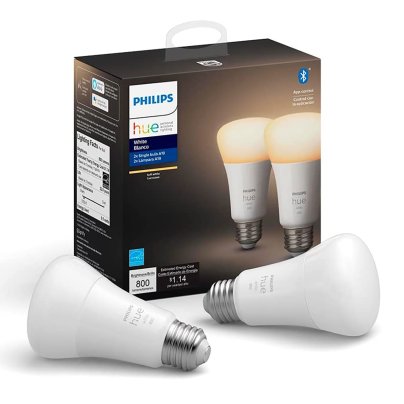
We may earn revenue from the products available on this page and participate in affiliate programs. Learn More ›
Using energy-efficient light bulbs is a simple way to help reduce your bills. Having energy-efficient bulbs on hand makes it easy to replace old bulbs as they go out. A light bulb may seem small, but exchanging your old bulbs for energy-efficient bulbs for an entire house makes a difference in your carbon footprint.
Energy-efficient bulbs come in a wide range of designs, from different shapes and watts to the type of bulb: halogen, CFL, or LED. A high-quality energy-efficient bulb not only saves energy and money, but also can illuminate a room. The bulb should complement the home’s interior and lighting design. The best energy-efficient light bulbs reduce energy use, provide the right kind of lighting for the space, and last longer than incandescents.
- BEST OVERALL: Philips Hue White 2-Pack A19 LED Smart Bulb
- BEST BANG FOR THE BUCK: Philips LED Frosted, Soft White Light, 16-Pack
- BEST SMART COLOR CHANGING: LUMIMAN Smart Light Bulbs, Wi-Fi LED
- BEST LED: SYLVANIA LED A19 Light Bulb
- BEST DAYLIGHT LED: Energetic 24-Pack A19 LED Light Bulb
- BEST CFL: PHILIPS LED 100-watt Equivalent, CFL Light Bulb
- BEST HALOGEN: SYLVANIA Halogen Light Bulb
- BEST VINTAGE: Ascher Vintage LED Edison Bulbs 6W
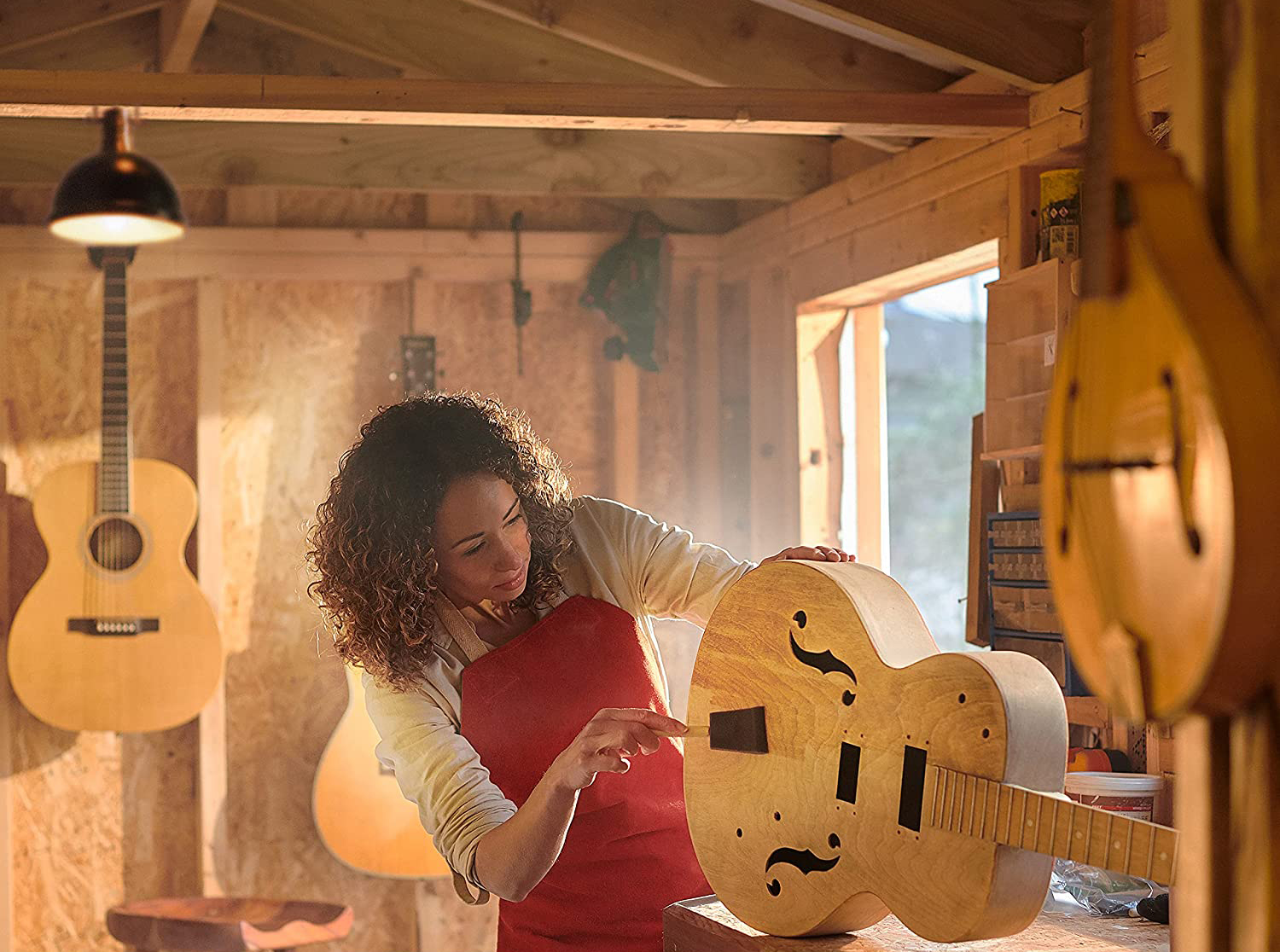
What to Consider When Choosing the Best Energy-Efficient Light Bulbs
Different types of energy-efficient light bulbs fit different fixtures and design schemes. When shopping, also consider the brightness, watts, and color temperature to make sure the bulb supports the purpose of the room and lighting goals.
Type
Types of bulbs include:
- Incandescent: Incandescent bulbs contain a filament that’s heated with electricity until they glow to make light. They’re covered in glass that also gets hot. Heat isn’t energy, so a lot of energy is lost to heating the filament, making these bulbs the least energy efficient. When discussing energy efficiency, they’re used as the basis of comparison for all bulbs.
- LED: LED bulbs are the most energy-efficient option, using 75-percent less energy and lasting 25 times longer than a standard incandescent bulb. They brighten to full intensity from the moment they’re turned on. Some also are dimmable, work with motion sensors, or timers. LEDs don’t show colors as accurately as other bulb types. They’re also usually larger and sometimes heavier than other types of energy-efficient bulbs.
- CFL: CFLs (compact fluorescent lamps) are a smaller version of full-size fluorescent lights. CFLs use from 50- to 80-percent less energy than an incandescent bulb, yet they offer equally bright light. CFLs take a few minutes to warm up to reach full brightness. That’s particularly noticeable outdoors, where cold temperatures can extend warming time. CFLs don’t usually work with dimmers, timers, or motion sensors, and they sometimes distort colors. CFLs must be disposed of properly because they contain mercury, which isn’t dangerous when the bulbs are in use and intact.
- Halogen: Halogen bulbs use about 25-percent less energy than an incandescent bulb, and they show true colors better than other energy-efficient options. They contain a tungsten filament encased in quartz filled with halogen gas. The quartz resists heat better than glass, and the halogen gas inside the bulb is more efficient than that in an incandescent bulb. The result is a bright light that uses less energy. They’re also usually smaller than incandescent bulbs. The bulbs reach full brightness right away, and they’re dimmable.
Brightness and Watts
Watts indicates how much electricity a light bulb uses. Brightness, measured in lumens, is a measure of how much light the bulb emits. A 40-watt incandescent bulb typically gives off 400 lumens of light. However, halogen, CFL, and LED lights use fewer watts but emit an equal amount of lumens. For example, both a 4-watt LED light bulb and a 25-watt incandescent bulb emit 220 lumens; however, an 18-watt halogen bulb also gives off around 220 lumens.
Some types of bulbs are more efficient than others, which can make choosing a bulb for energy efficiency a bit confusing. Check the watts versus lumens to get a better idea of the bulb’s energy efficiency. The more lumens per watt the bulb offers, the more energy efficient it is.
Color Temperature
Color temperature, measured in Kelvins, indicates the warmness or coolness of the light. The Kelvin scale runs from 1,000 to 10,000. Lights under 3,000K give off warm (yellowish) light that’s often called “soft white” in the bulb’s description. This dimmer light feels cozier and is more likely to be used in restaurants and bedrooms for general ambient lighting. It’s not as suitable for task lighting.
“Bright white” and “true white” bulbs fall between 3,100K to 4,500K. At this color temperature, the light has a cooler, almost blue, light. This type of light is better for task lighting, such as in the kitchen, bathroom, and areas in which the user needs the ability to see fine details. However, it’s not as bright as bulbs designed to mimic sunlight.
Between 4,600K and 6,500K is a true blue light that’s similar to sunlight. This light is bright and has a more perceptible blue hue than bright white or true white bulbs. It’s better suited for areas in the home used for reading, displaying, or performing tasks. Some users like this temperature in the bathroom for makeup application or in the kitchen for detailed prep work. These bulbs are also well suited for outdoor security lights.
Blue light suppresses the release of sleep hormones. Bulbs over 4,600K are the best light bulbs for kitchens or home offices. Bulbs that allow users to adjust the color temperature are a good solution for homes with multipurpose areas.
Shape and Compatibility
Check a bulb’s compatibility with a light fixture by looking at the wattage rating of the fixture to ensure the bulb’s wattage doesn’t exceed the fixture’s maximum rating. A compatible bulb is at or under the maximum wattage.
Also look at the bulb’s base size, because bulb base sizes vary as well. Sometimes, the fixture has a sticker near the base indicating the correct bulb base size. However, a comparison with the old bulb is sometimes the only way to ensure the bulb is compatible.
Bulbs are also classified by shape:
- A-series: With a classic incandescent light bulb shape, A-series bulbs can be used throughout the home for ambient and task lighting, depending on the bulb’s color temperature.
- E and ER-series: These bulbs are used for recessed lighting, as well as for outdoor fixtures, ceiling fans, and string lights.
- G-series: G-series or globe bulbs are round and used for task lighting and bathroom vanities.
- Edison bulbs: Vintage-inspired bulbs with exposed filaments provide warm, cozy mood lighting and are used in everything from chandeliers to outdoor string lights.
Lifespan and Operating Cost
Manufacturers list a bulb’s lifespan on the packaging. However, estimates are based on operating the bulb for 3 hours per day. Energy-efficient bulbs are typically listed as lasting anywhere from 10 to 25 years. However, if the bulb is used longer than 3 hours per day, its lifespan will be far less. The packaging also lists the estimated operating cost per year. Like the estimated lifespan, if the bulb is used longer than 3 hours a day, it will cost more per year to operate. These estimates are useful for comparing energy efficiency.
LED bulbs can cost more up-front than other types of energy-efficient bulbs, but they also last much longer, typically at least 10,000 hours. CFLs can last about that long, with halogen bulbs operating for around 2,500 hours and incandescent bulbs lasting approximately 1,200 hours. While LED bulbs are more expensive up-front, they can save money in the long run.
Additional Features
- Smart bulbs: Smart bulbs connect to a smart hub or home Wi-Fi. Depending on the home setup, they can be controlled by voice and/or through an app. These bulbs allow users to turn lights on and off from any location with a Wi-Fi connection. Some bulbs can change color or temperature or offer other effects. Users also may be able to set a schedule, so the lights come on at predetermined times.
- Dimmable: Dimmable bulbs let users control the amount of electricity sent to the bulb, dimming or brightening the light. These types of bulbs provide more control over how much electricity is used. However, not all bulbs or light switches are dimmable. Both a dimmable bulb and a dimmer switch are required to control electricity this way.
- Weather resistant/outdoor: Outdoor or weather-resistant bulbs resist moisture and harsh weather conditions, so they’re a good choice for the outdoors.
- Color changing: Color-changing LEDs contain blue, red, and green light diodes. By adjusting the intensity of each color, the perceived light of the bulb changes. This is a common feature with smart bulbs, but some traditional LEDs also can cycle through colors.
Our Top Picks
The bulbs that made our list come from trusted brands and offer excellent illumination and energy efficiency. The list includes bulbs of different types to meet the various needs around the home, from the bedroom to outdoor lighting.
Best Overall
Philips Hue White 2-Pack A19 LED Smart Bulb

Pros
Cons
Product Specs
- Watts: 9.5
- Lumens: 800
- Color temperature: Adjustable
The Philips Hue white smart bulbs provide a powerful addition to any home but particularly to a smart home. We gave them the best overall award, but they’re also a top runner for the best smart bulbs.
These bulbs are Energy Star certified, meaning that they use 90-percent less energy, last 15 times longer, and comply with the Environmental Protection Agency’s quality and efficiency standards. Philips Hue smart bulbs are estimated to last up to 25,000 hours. They’re dimmable, and users can adjust the brightness and the color temperature according to the time of day or the task at hand through the Hue app.
Philips Hue bulbs are compatible with IFTTT, Apple HomeKit, Amazon Alexa, and Nest. Up to 10 bulbs can be connected to the app or the Hue hub. However, these Philips bulbs are expensive. For those who don’t want or need color temperature and remote light control, a less expensive option may work.
Get the Philips Hue white LED smart bulbs at
Amazon
,
Best Buy, or The Home Depot.
Best Bang For the Buck
Philips LED Frosted, Soft White Light, 16-Pack
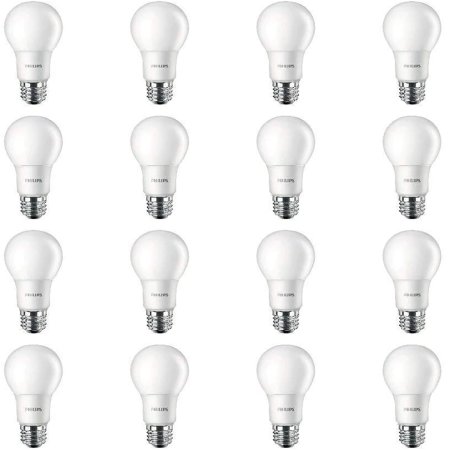
Pros
Cons
Product Specs
- Watts: 10
- Lumens: 800
- Color temperature: 2,700K (soft white)
The Philips LED frosted bulbs save energy yet still provide a soft white light for ambient lighting. Using them is a simple way to be more energy efficient without an app or Wi-Fi connection. These LED bulbs cost a fraction of most energy-efficient bulbs, yet they’re still estimated to run up to 10,950 hours.
The bulbs fall in the soft white light range, with a color temperature of 2,700K. These bulbs won’t dim as they age, staying at their full 800 lumens until they go out for good. Buying the bulk 16 pack of bulbs reduces the price of each bulb and provides enough bulbs to stock up or change out most of the bulbs in an entire home. However, they don’t have as many lifetime hours as some of the more expensive bulbs.
Get the Philips frosted LED light bulbs at
.
Best Smart Color Changing
LUMIMAN Smart Light Bulbs, Wi-Fi LED
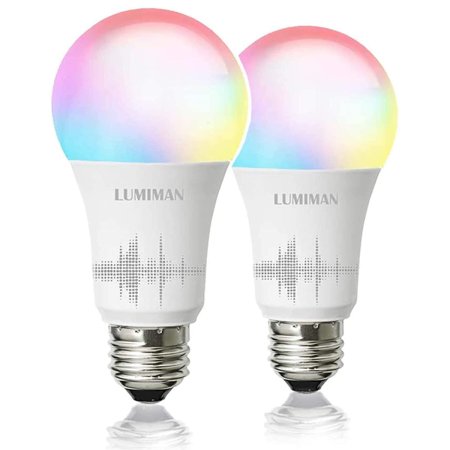
Pros
Cons
Product Specs
- Watts: 7.5
- Lumens: 800
- Color temperature: Varied
LUMIMAN smart light bulbs offer a wide range of control features through an app. Users can adjust the brightness from 2,700K to 6,500K, which provides the ability to set a mood or adjust the light based on the time of day. They’re compatible with Siri, Alexa, Google Home, and Echo.
These lights are dimmable, and the app allows for some impressive control features. For example, users can set up a group, a timed schedule, and color themes like sunlight or sunset. There’s also an option to create customized DIY color settings. LUMIMAN bulbs can even sync with music. They provide 800 lumens using only 7.5 watts.
Get the LUMIMAN smart light bulbs at
.
Best LED
SYLVANIA LED Light Bulb
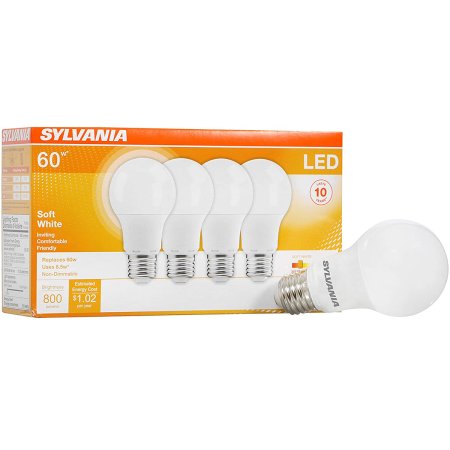
Pros
Cons
Product Specs
- Watts: 8.5
- Lumens: 800
- Color temperature: 2,700K (soft white)
These Sylvania LED light bulbs are estimated to last up to 11,000 hours, or the equivalent of 10 years. They create 800 lumens while using only 8.5 watts. At 2,700K, they emit a soft white light that makes them one of the best bulbs for bedroom use and gathering areas in the home.
As an LED light, they don’t need to warm to reach their full brightness. These Sylvania bulbs are usable in damp environments indoors or out. Designed to reduce shatters, they resist shocks and vibrations.
Get the Sylvania LED light bulbs at
Amazon and The Home Depot.
Best Daylight LED
Energetic 24-Pack A19 LED Light Bulb
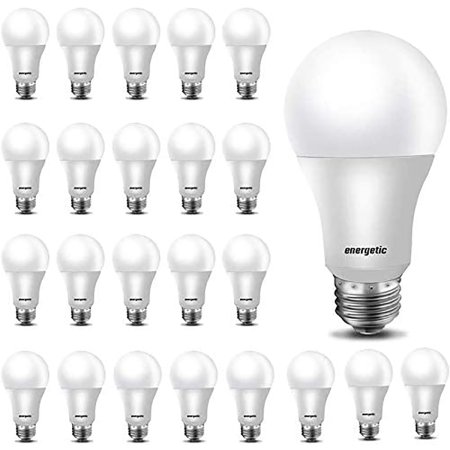
Pros
Cons
Product Specs
- Watts: 8.5
- Lumens: 750
- Color temperature: 5,000K
These Energetic LED light bulbs provide 15,000 lifetime hours. Their 5,000K color temperature rivals daylight, so they’re ideal for bright task lighting. In rooms like the basement, bathroom, or kitchen, this kind of light illuminates in greater detail and offers the best contrast between colors. They don’t lag in reaching their full 750 lumens. These bulbs aren’t just a good deal over the long term; they’re also affordably priced for those on a tight budget. While they emit a decent 750 lumens at 5,000K, some people find them too bright for regular lighting.
Get the Energetic LED light bulbs at
Amazon
.
Best CFL
PHILIPS LED 100-watt Equivalent, CFL Light Bulb
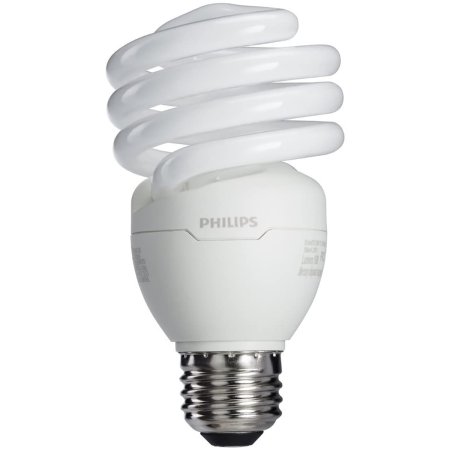
Pros
Cons
Product Specs
- Watts: 23
- Lumens: 1,600
- Color temperature: 6,500K
These Philips light bulbs are daylight CFLs that use only 23 watts to create 1,600 lumens. Philips also bumps up the eco-friendliness by using recycled glass and packaging materials.
The bulbs are designed to mimic the sunrise in their brightness. They’re a compact bulb to better fit traditional fixtures. Based on efficiency, the Philips CFLs are estimated to last 9.1 years when on for 3 hours per day. As a typical CFL, they take a few minutes to reach full brightness.
Get the Philips CFL light bulb at
Amazon
.
Best Halogen
SYLVANIA Halogen Light Bulb

Pros
Cons
Product Specs
- Watts: 43
- Lumens: 610
- Color temperature: 2,750K
The Sylvania halogen light bulbs bring the benefits of halogen to the home with an efficient design that renders true colors. These indoor/outdoor bulbs can last up to 2,000 hours. While not as efficient as LEDs or CFLs, they’re still a good replacement option for incandescent bulbs.
One of their main benefits is the quality of the light they offer. They don’t distort colors, creating true color renditions. The bulbs are dimmable and frosted, further dispersing their warm white light. While these bulbs are water-resistant, they aren’t designed for direct exposure to inclement weather.
Get the Sylvania halogen light bulb at
Amazon
.
Best Vintage
Ascher Vintage LED Edison Bulbs 6W
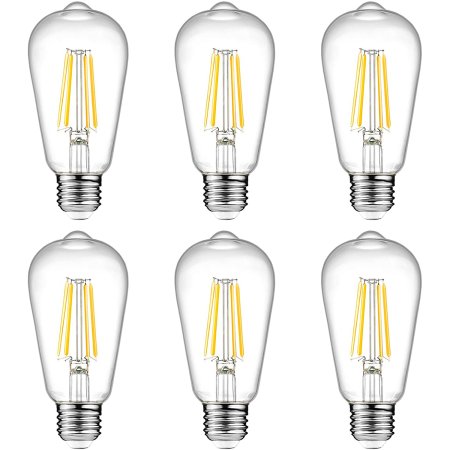
Pros
Cons
Product Specs
- Watts: 6
- Lumens: 700
- Color temperature: 2,700K
Ascher Vintage LED Edison Bulbs have visible filaments that reach full brightness using only 6 watts. Their 700 lumens put out a soft white light that stays at 2,700K. They require no lag time to reach their full illumination. The power consumption is low enough that they’re estimated to last up to 20,000 hours.
At 2,700K, they’re ideal for ambient lighting. However, they’re also sold in different color temperatures, so options exist for task lighting. Users should take care to order the desired color temperature. It’s easy to accidentally order a color temperature that’s too cool or warm for the bulb’s intended purpose.
Get the Ascher vintage LED Edison bulbs at
.
Our Verdict
The Philips Hue White 2-Pack A19 LED Smart Bulb is our top pick based on quality and versatility. It’s a bit pricey, but offers excellent control over lighting while saving energy. For those on a tighter budget who don’t need a smart bulb, the Philips LED Frosted, Soft White Light, 16-Pack of bulbs is an excellent choice. This is a bulk pack with enough bulbs to replace most of the bulbs in a single home.
How We Chose the Best Energy-Efficient Light Bulbs
We researched how energy efficiency is measured in light bulbs and which specs determine the best investment for buyers. We determined that the bulbs’ watts and lumens were the best indicators for energy efficiency but weren’t the only factors that determined our choices.
We also considered the color temperature options, extra features, and durability of the bulb. Color temperature helps determine the rooms in which the bulbs work best. Extra features like dimming can further increase energy efficiency, while attributes like water resistance may better fit certain uses. While color temperature advantages are based on bulb location and buyer preference, we looked for bulbs within the different color temperatures for ambient, task, and accent lighting.
FAQs
Maybe you already know where you want to use energy-efficient bulbs, but you’re still not sure exactly which bulbs you need or how to maintain or dispose of them. We answer a few common questions here to help.
Q: Which light bulb is the most energy-efficient?
LED bulbs are the most efficient, using 75- to 90-percent less energy than a standard incandescent bulb. Look for one that’s compatible with the fixture, area of use, and desired control options.
Q: Do LED bulbs really save money?
Yes, LED bulbs save money when compared to traditional incandescent bulbs. They use less energy to provide the same amount of light and last longer.
Q: How do you dispose of energy-efficient light bulbs?
Halogen and incandescent bulbs can be wrapped in their packaging for disposal to prevent them from breaking. You can then dispose of them in the household garbage. LED bulbs are recyclable, though they also are safe for household disposal. CFL bulbs contain mercury and shouldn’t be placed in household garbage. If broken, they can leak toxins. Many major home improvement stores accept them for recycling, so check online for a recycling location near you.
Q: How do energy-efficient light bulbs help the environment?
Energy-efficient light bulbs help the environment by reducing energy use and the number of light bulbs that end up in landfills.
Q: Do energy-efficient light bulbs contain mercury?
CFL bulbs contain mercury, but they aren’t dangerous as long as they are intact. However, if they get broken, everyone should leave the room, including pets. Then follow the EPA guidelines for cleanup. CFLs should be taken to a recycling center or home improvement store that recycles CFLs to make sure the mercury does not leach into the area around a landfill.
